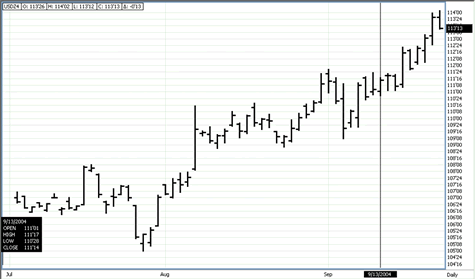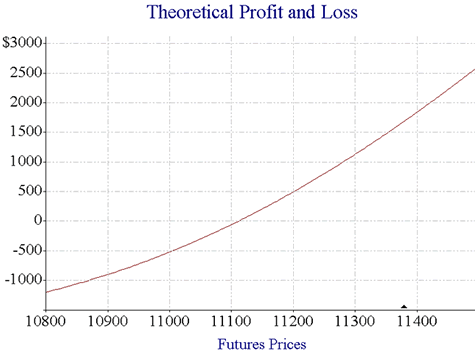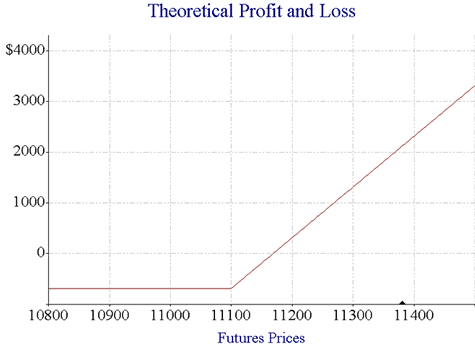Have you purchased an option position in the past, and had the market move in your favor, only to ultimately lose money on the trade?
Read this article and you might get some answers about why it happened…
Futures options are both widely used and often widely misunderstood. Countless times I have heard stories from traders telling me how they bought a call, and the market rallied as they expected, yet they lost money. This is not an unusual situation, as option prices are a function of more than just price. Options are priced using the following:
- The underlying futures price
- The option’s strike price
- Current interest rates
- Implied volatility
While the first three items are self-explanatory, the last item, implied volatility, is a little more complicated. For the sake of simplicity, I will offer a brief explanation of implied volatility
What is implied volatility?
Implied volatility is the option market’s best guess at how volatile the underlying futures contract will be during the remainder of the option life. For example, we would reasonably expect implied volatility in corn to be greater in May, ahead of the critical pollination stage for corn, than we would in November, after the crop has been harvested. Corn price volatility is usually more volatile in the spring and summer, as weather is a large unknown. At the end of the season after the corn crop has been harvested, there is generally less uncertainty and therefore less price risk. This is typically reflected by lower implied volatility in corn options in the fall.
A classic futures option buying example
Let us examine a classic example of how many traders buy options:
Any trades are educational examples only. They do not include commissions and fees.
A trader reads a bullish article in a newspaper over the weekend regarding Orange Juice, and the potential for frost damage. Orange Juice futures have already rallied to 80 cents, but could go much higher if a severe freeze were to damage the crop. The trader suspects that if a freeze does not materialize, prices will likely sell off hard, and he does not wish to accept that risk. Monday morning the trader pays 2.65 cents ($397.50) for a 90-cent call that has 90 days until expiration, and is 10 cents out of the money. The implied volatility is relatively high at 40%, but the trader likes the security of knowing the most he can lose is the premium he paid plus fees.
Does this strategy appear sound? Have you perhaps purchased an option in a similar manner?
How you can be “right” and still “wrong”
Let us assume that there is a minor frost event that keeps prices from dropping, and at the end of ninety days orange juice futures have rallied 11 cents to 91 cents. The trader was mostly correct in his analysis, because over the ninety-day period the futures have rallied 11 cents or 13.75%. Unfortunately, our trader needed the market to be at 93 cents, or a 16.25% increase to break even. The trader swears off options, or potentially worse yet, starts looking at only option selling strategies.
Too late, too far away, too much time
Let us dissect the trader’s actions and see what mistakes he made with this trade:
Any trades are educational examples only. They do not include commissions and fees.
The first mistake was reading a newspaper article and simply buying a call the next business day. If a major news event or story is in the newspaper, it is generally priced into the market. At any given time, option prices will typically reflect any potential price risk that is anticipated for the underlying futures. This is frequently made worse by the additional interest a news story or event brings to the market. In our example, prices may have been higher for the options in part due to the frost concern news, and in part due to the demand for call options this news brought.
Do you ever know how far a market might move? Keep your strike prices close to the money.
The second mistake the trader made was to buy an option that was too far out of the money. You will recall that he bought a 90 cent call when the underlying futures were at 80 cents – thus his chosen option strike was 12% out of the money. In the world of Internet stocks, a 12.5% move is not unusual, but in the world of physical commodities that is a large move on a percentage basis. Part of the reason that futures contracts offer leverage is that commodities typically do not make large moves in percentage terms very often. The further away an option strike price is from the current futures price, the less likely it will trade in the money. It is a simple fact of statistics that moves of greater variance are less likely.
Time may not be on your side
The third and probably the most important mistake was the length of time remaining on the option. I contend that an option with 90 days remaining until expiration has too much time value to potentially take advantage of a short-term expectation in the underlying futures contract.
A controversial claim?
The third item above is likely to raise many eyebrows as conventional wisdom suggests that short-dated options rapidly lose their time value and should be sold, not bought. I argue that the trader would have been better off with a short-dated option for several reasons.
Start at the beginning – what is your core strategy?
By definition, an option is the right, but not the obligation, to buy or sell an underlying futures contract at a specific price within a specific time. In my opinion, the greatest benefit to buying options is that if you are correct in your speculation, the option becomes a futures contract. If you are wrong in your opinion of the market, your risk is limited to the premium you paid, plus execution fees. With this approach, the strategy is to purchase an option that will very quickly behave like an outright futures contract, assuming your prediction of market direction is correct.
When most traders are in a winning trade, they wish they had more contracts on and when they have a loser they wonder why they entered the trade in the first place. The proper use of short-dated options potentially allows the trader to have a larger futures position when they are right, and no futures position when they are wrong.
How and when can options “behave” like a future? An explanation of “delta”
If we look at a long call option position, we see that an at-the-money call has a delta of 50. This means that the option is expected to reflect 50% of any move in the underlying futures contract. As the price of the underlying rises, the call option will reflect more of the futures price movement. This will happen until the Delta is 100. At that point, the call option is essentially equivalent to one contract of the underlying futures contract and its price should move in tandem with the futures. The potential disadvantage for longer-term options in this regard is that longer time value slows the speed at which Delta changes. In contrast, short-term options are quicker to behave like a futures contract because their Delta increases more rapidly when the market moves in their favor.
Short-term futures option example
The Analysis – more than just a newspaper story:
Any trades are educational examples only. They do not include commissions and fees.
We will look at a new example using the 30-year Treasury Bond contract at the Chicago Board of Trade. On September 13, 2004, our trader feels that bonds are heading higher. He feels the Iraq war, along with higher oil prices, will keep interest rates low ahead of the election. He anticipates that the market place will be disappointed by the retail sales on the 14th as the Southeastern US has been hit by hurricanes. Our trader knows that the FOMC meeting is scheduled for September 21, 2004 and thinks the Federal Reserve action will be negative for long-term rates.
30-Year Treasury Bond Futures Chart

The Options vs. Futures decision
The morning of the 13th, our trader looks at three ways to potentially take advantage of his bullish market outlook. The December bonds in the electronic market overnight trade are at 111-01, down 2 ticks from Friday’s close. The December 111 call option which expires November 26, 2004, settled at 1-57/64 ($1890.625) on Friday and the October 111 call option which expires September 24,2004, settled at 44/64 ($687.50). The trader thinks the bonds could rally 3 full points or $3000 per contract in the next two weeks. If he is wrong, he feels the futures could easily lose 1 1/2 -2 full points or $1500-$2000 – a risk he is not willing to take on an outright futures trade. Because of this, he decides that a long call option strategy will best meet his risk parameters and potential profit objectives.
Which option strategy would you choose?
This is where things get interesting, as our trader has a couple of choices using call options. Conventional wisdom would say to buy the option that has more time until expiration because it will decay at a slower rate if he is incorrect with market prediction. In theory this is true, and if bond prices were to remain constant, the December option will lose a smaller percentage of its value daily. Conversely, the October option will lose a larger percentage of its time premium every day, as there are only 2 weeks until option expiration (zero time value).

But remember: You want the option to potentially behave like a future…
At first, the fact that the October call will lose its entire time premium in 2 weeks seems like a negative characteristic. But remember, for the option to behave like the underlying futures contract, it needs to have very little time premium remaining. If he buys the December option, he will need to see almost 2 full points of time premium erode before the option behaves like a future. In this example, suppose the bond market acts extremely well and rallies 5 points to 116-00 in the two weeks. The October option will be worth its intrinsic value (amount it is in-the-money), or 5 points ($5000). Our trader would have captured 4 10/32 ($4312.50) of the move with the October call. On the other hand, the December option will likely be worth about 5 16/64 ($5250). The option will have gained approximately 3 12/32 ($3375) of the 5-point move. In this hypothetical example, the return on the October option was almost 1 full point, or $937.50 better than the December option.

Any trades are educational examples only. They do not include commissions and fees.
Less time value = less risk when you’re wrong
The short-dated option worked better in the winning scenario, but what about when the trader is wrong? In simple terms, the October call cost about $1200 less than the December call, therefore the dollar risk is lower. If the market went sideways over the 2 weeks and the futures settled at 111-00, the December options would outperform the October by about 20/64-24/64 or $312.50-$375.00. If the market sold off during that time period the difference between the values would narrow. In a worst case scenario where the bond market went only lower and both options expired worthless, clearly the October option would have provided a smaller loss.
Summary
It is important to note that although the examples provided in this article involved purchasing calls, all of the core principles discussed apply to purchasing puts for markets poised for a potential move to the downside
This article has sought to provide traders with a new perspective and method on how to buy options to trade specifically timed or news-based events. It can be said that short-time frame options potentially offer the best of both worlds. With these methods, a trader may achieve their goal of owning an option strategy that acts like a futures position when they are correct, while maintaining the attractive option feature of having risk limited to the premium and fees paid to purchase the option position.
